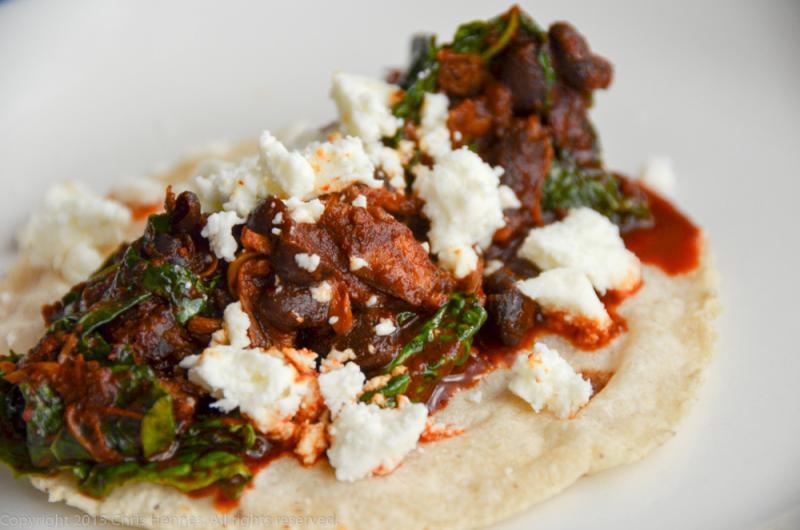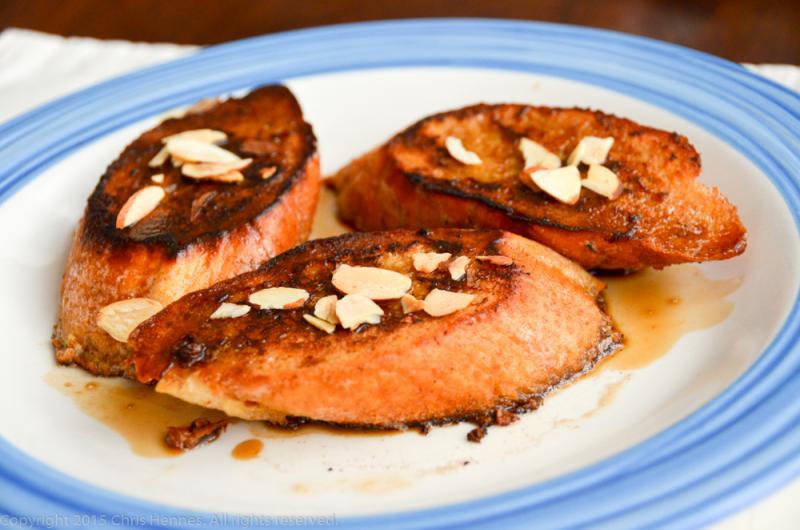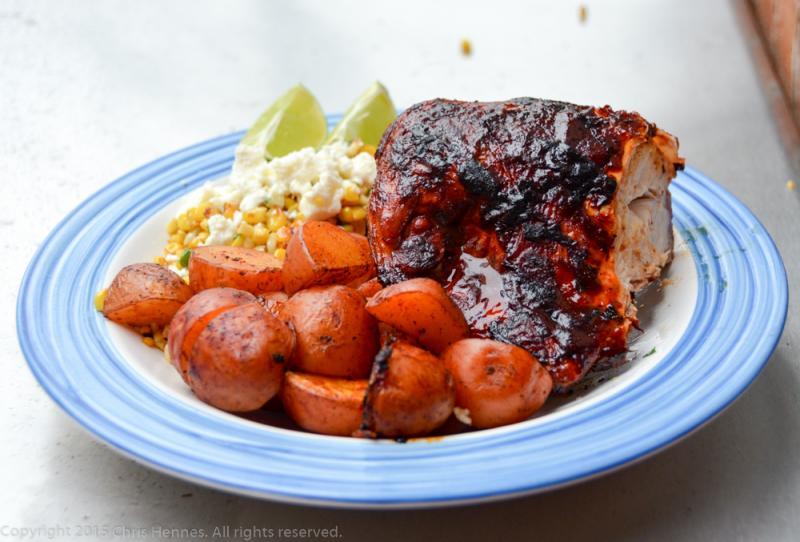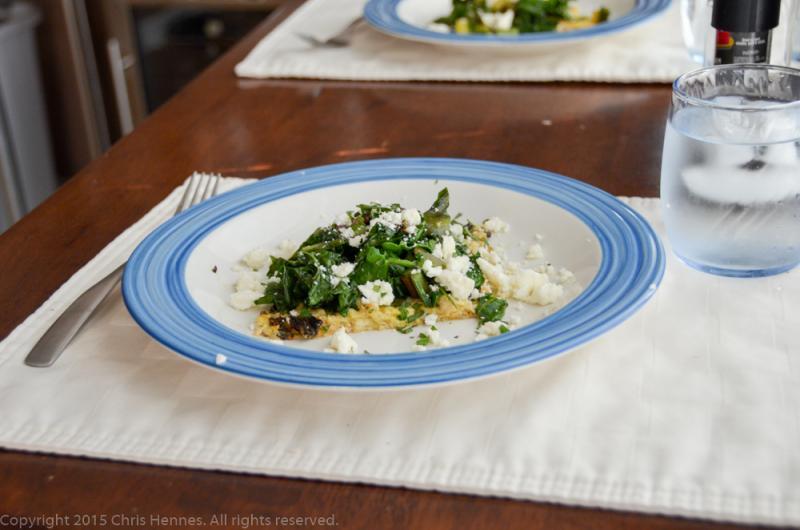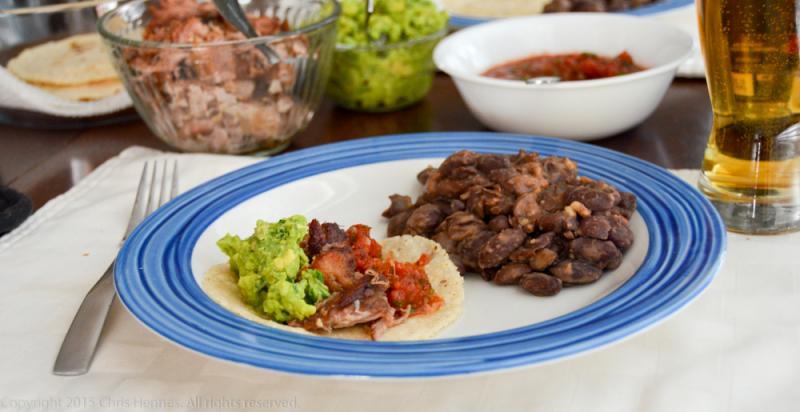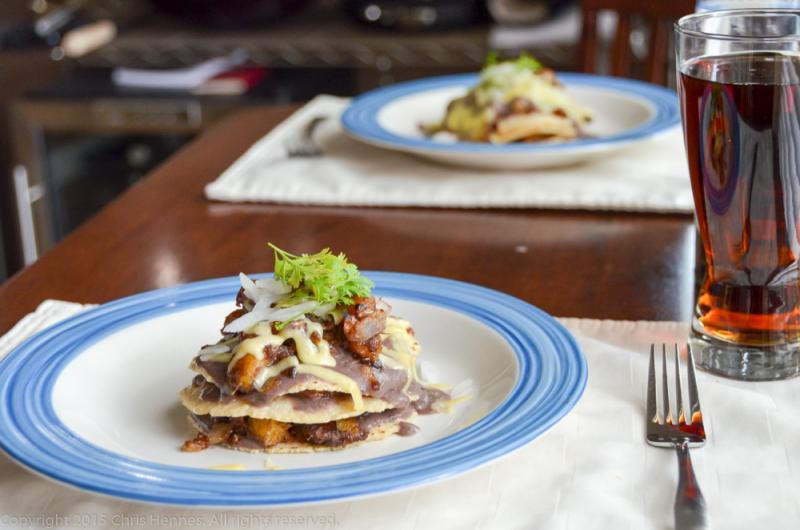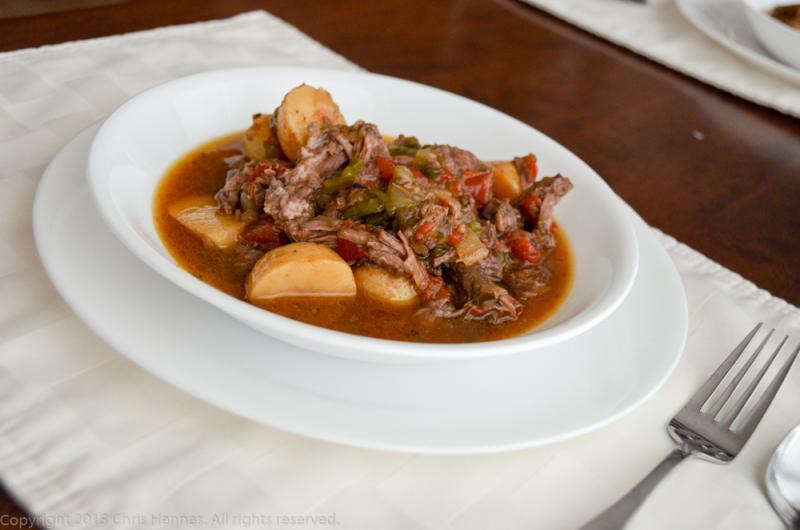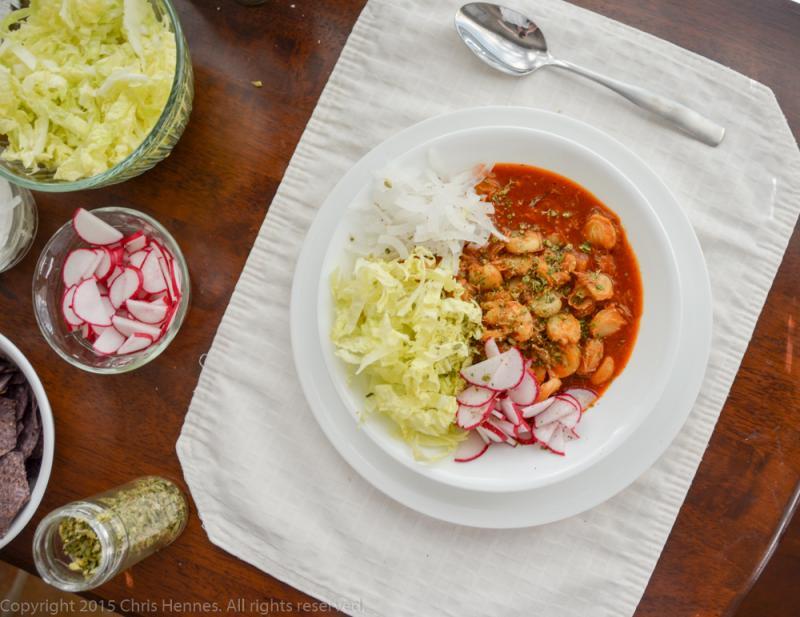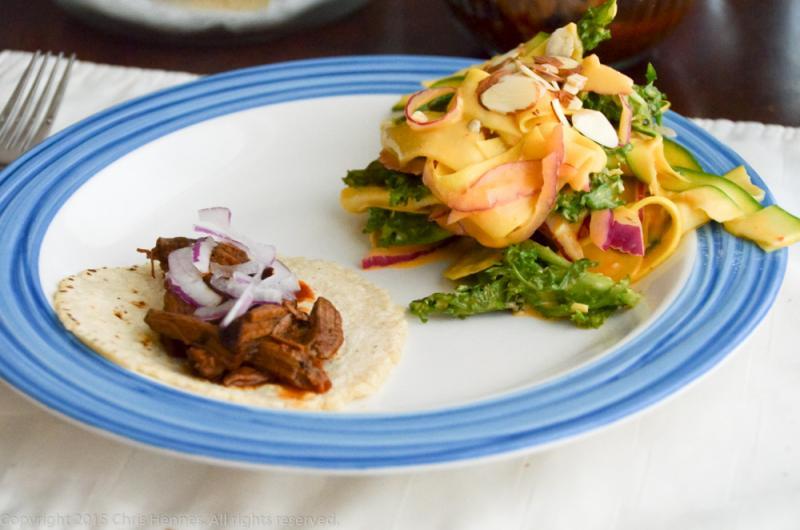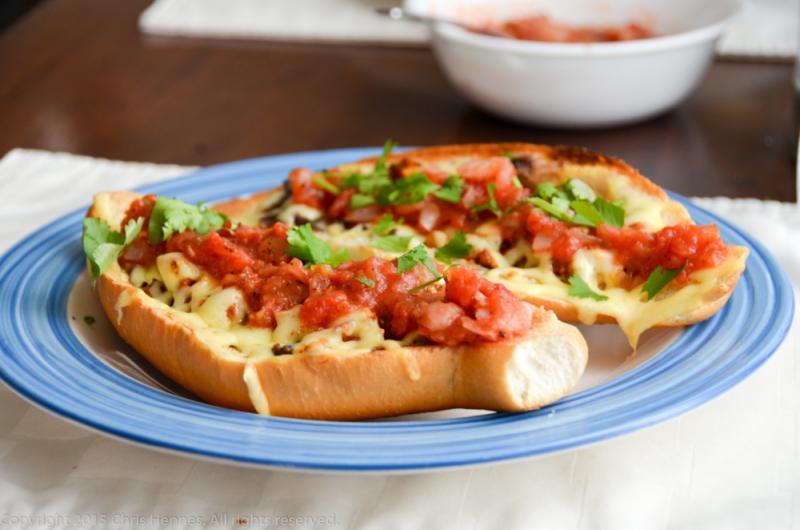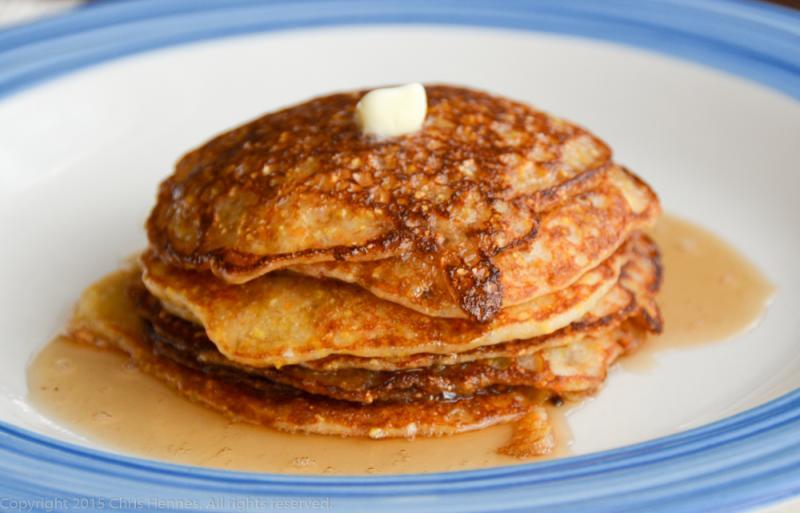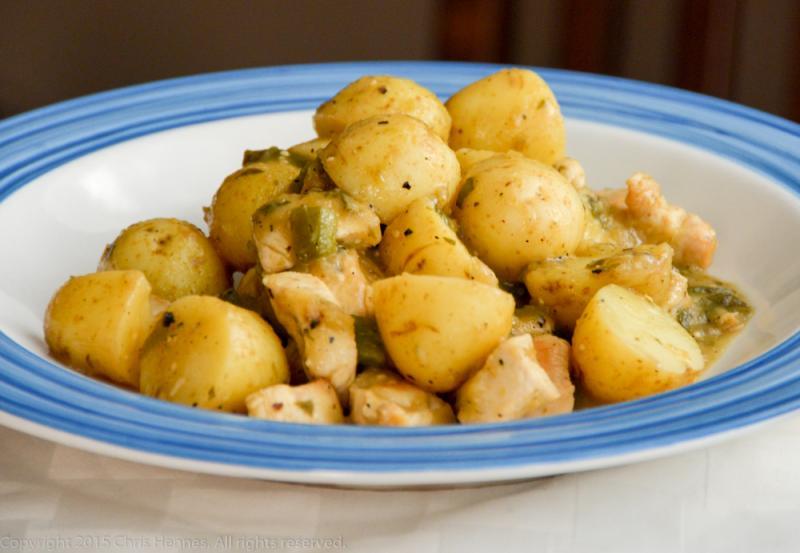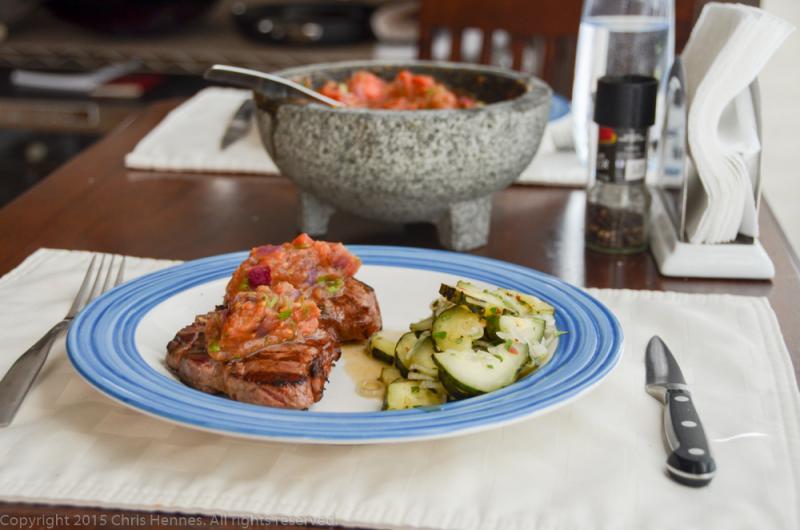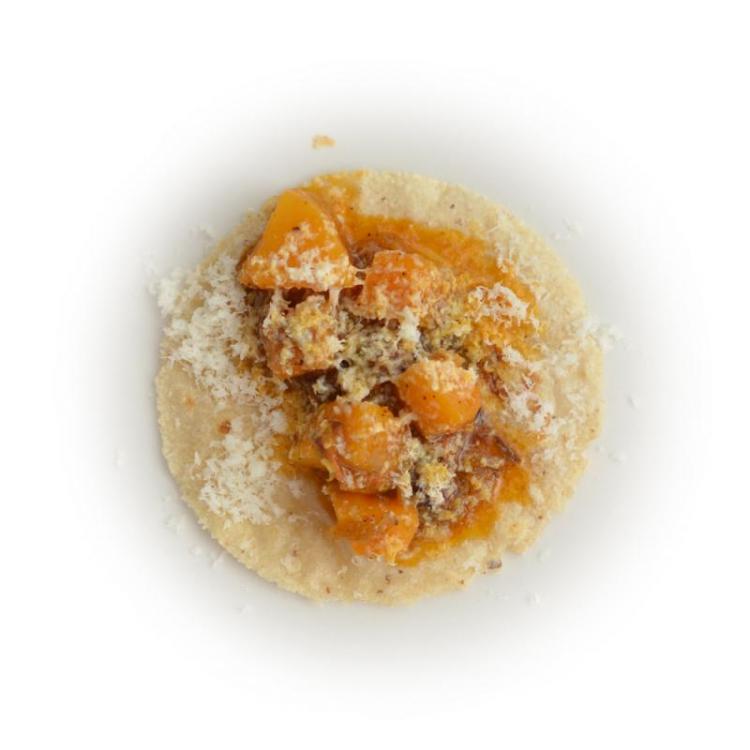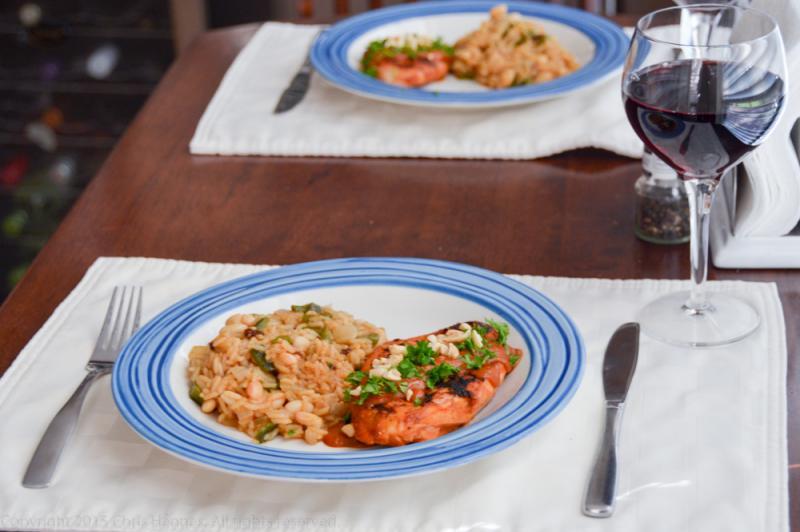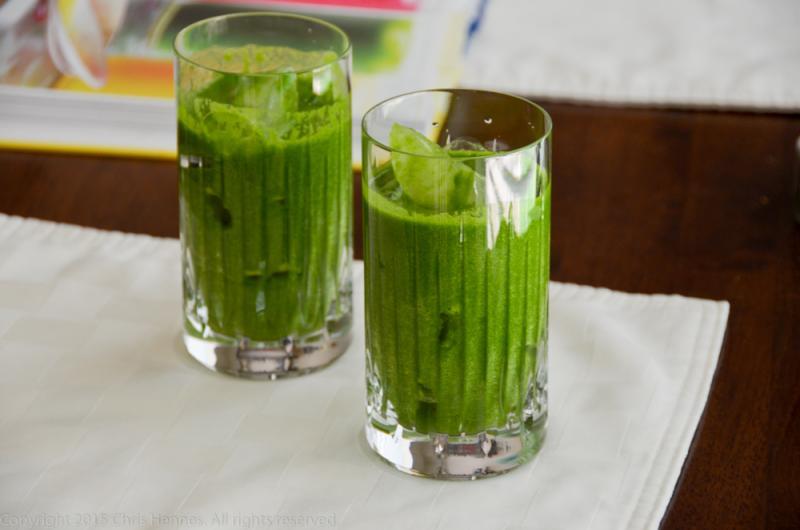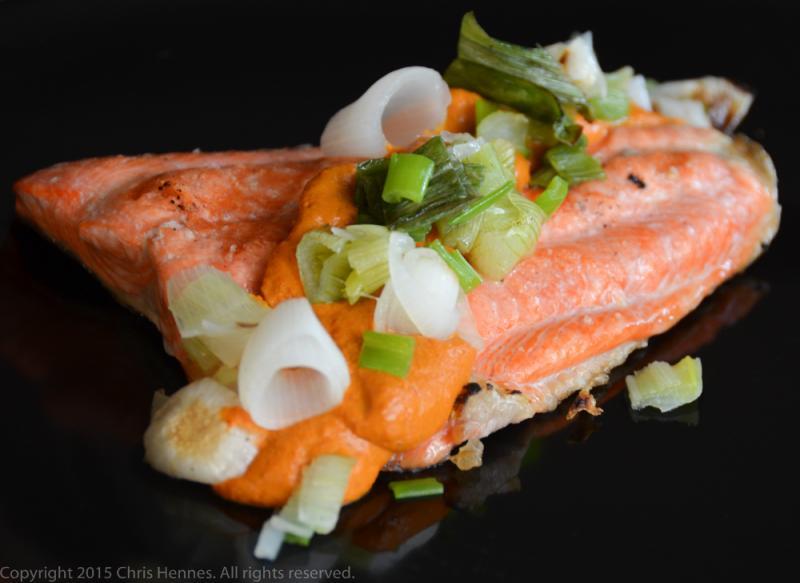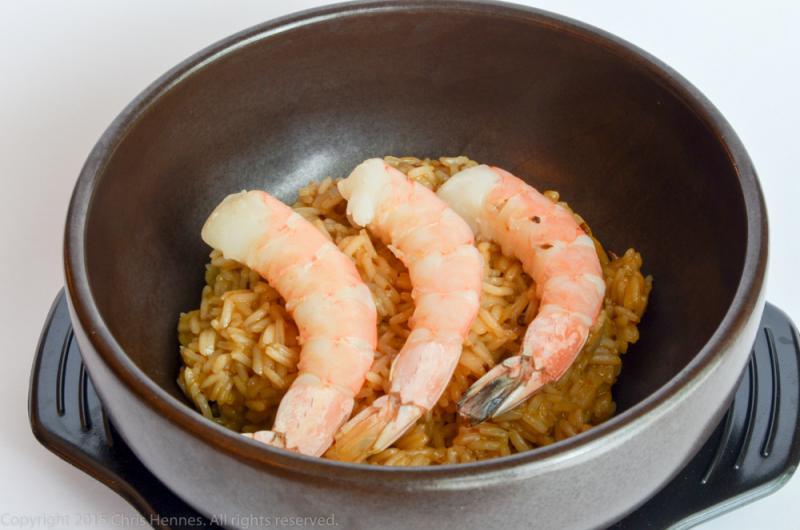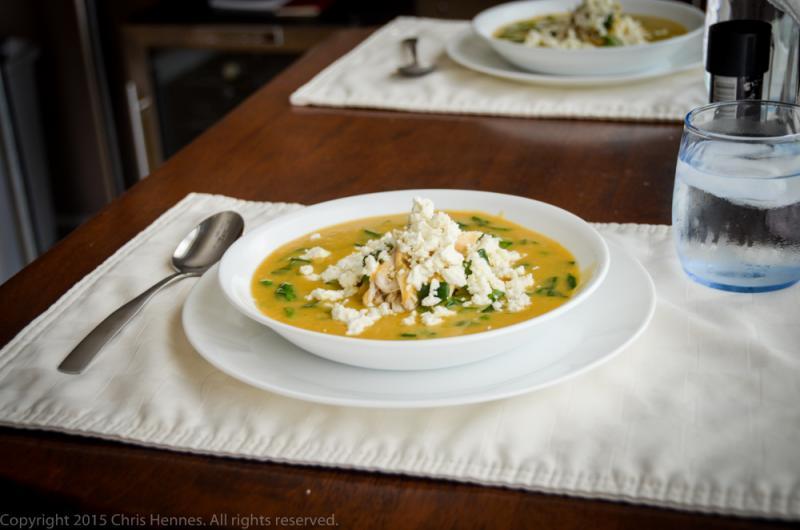-
Posts
10,190 -
Joined
-
Last visited
Content Type
Profiles
Forums
Store
Help Articles
Everything posted by Chris Hennes
-
Greens and Beans with Red Chile and Fresh Cheese (p. 125) My initial reaction to this as I was making it was that the sauce was quite bitter. It consists almost entirely of fried guajillo chiles, with just a bit of garlic and oregano added. The complexity of the chiles was wonderful, but tasted in isolation the bitterness was the first thing you noticed. After salting it a bit more and then adding the beans and greens (and some leftover carnitas for good measure), it actually balanced out. It's probably not my favorite dish of the book, but in the end it really was quite good, and highlighted the guajillo chiles in a unique way. I've used guajillos in tandem with other chiles and other flavors before, but never quite this isolated, as the central flavor of the dish. They are a great chile.
-
Horchata French Toast (p. 243) Piloncillo Syrup (p. 244) The recipe suggests that you can make this with a 15-minute soak, but whether it was because mine was foamier that expected or because that is over-optimistic, my one complaint about this dish is that the bread needed more time in the liquid. He suggests that you can do an overnight soak if you want to, and I'd suggest that is probably a good idea. The taste was good (though not all that different from "regular" french toast), but the texture sufferred. The piloncillo syrup was excellent, and in my opinion every bit the equal of good maple syrup. I was using a bag of Rancho Gordo piloncillo, so maybe this experience wouldn't hold if you were using a less exotic cone of the stuff from your local mercado, but made with the RG this is a superb syrup.
-
Red-Chile Roast Chicken (p. 112) Herby, Spicy Fried Corn (p. 146) If I'm being completely honest, roast chicken is never going to be my favorite food. Some people wax rhapsodic over this, that, or the other chicken, but for me, no matter what you do to it, it still ends up just a large chunk of meat on a plate with some seasoning on the exterior. And no matter how good the meat, "hunk of meat on a plate" is just not my cup of tea. If it's yours you may have other opinions about this recipe, but I found it sort of lackluster. I grill-roasted the chicken rather than using the oven (this despite the constant low-level rain we've seen today), but even that didn't really make up for what was ultimately chicken glazed with a BBQ sauce. As an aside, I think it was recipes like this that led to rancho_gordo's earlier comment about all the chile powder in the book. Basically every recipe in the book that calls for his Quick Red Chile Adobo sauce includes the recipe for that sauce (even though the idea is that you made it earlier and refrigerated it, and he's got several pages devoted just to that recipe at the beginning of the book). And the "Quick" version of that recipe uses ancho chile powder. The not-quite-as-quick version calls for whole chiles, as you'd normally expect, but that's not the one he repeats a half-dozen times in the book as a "if you don't have QRCA, here are the ingredients". I served this with the fried corn, which was delicious. I'd suggest that this would have also been sort of lackluster had it not been for his strong recommendation to use epazote as the herb, with cilantro and parsley as distant backup options. The epazote made this one. And good corn, of course.
-
rancho_gordo, I'd say that the recipes I intend to return to for sure are The Green Chile-Braised Beef with Caramelized Onions and PotatoesChicken with Roasted Tomatillos, Poblanos and PotatoesButternut with Bacon, Tomatillo and ChipotleCelery Root Pancakes with Chipotle Crema and CilantroSpicy, Garlicky Grilled Cauliflower Steaks with Browned Butter, Toasted Nuts and Tequila RaisinsRoasted Chayote with Herbs and Goat CheeseSpaghetti Squash Fideos with Chipotles, Chorizo, Crema and AvocadoCreamy Zucchini, Corn, and Roasted PoblanosThat's not to say I didn't like most of the others, but these were the real standouts for me so far. There have only been a few things I've made that I didn't really care for. Obviously, that's by construction, I started with the dishes I thought sounded the best, and I bought the cookbook because I knew I loved Bayless's take on Mexican food. Honorable mention goes to the Queso Fundido burger and the Chicken Soup -- both were excellent, but I don't generally use a recipe for either item, so to say I'd return to them would not be quite true.
-
Open-Face Red Chile-Chard Omelet (p. 230) The top-view photo of this in the book is basically the only even moderately photogenic side of this "omelet." It wasn't bad, but I don't think I'd make it again. I did like the addition of the crumbled ancho chile to the egg mixture, but honestly I think it would have been better without the chard (and rolled, rather than open-face). Then again, the recipe is supposed to produce a dish for four people, so I understand why you'd want an open-face omelet instead of individual rolled items.
-
Pork Carnitas Dinner (p. 280) I've made carnitas many times, following many recipes. As a general rule I prefer simpler versions. Cooking the pork in all sorts of exotic liquids sometimes results in good pork, and sometimes ends up a mess. I was happy to see that this version was a confit-style method, where you cook the salted pork submerged in lard in the slow cooker without anything else added. Naturally, as a follower of Modernist cooking, I swapped out the "submerged in lard" with "cooked sous vide with some lard added to the bag to fill the gaps." I went with 65°C for 48 hours, which I figure was sort of like using a really slow cooker, right? This was cooked last week, chilled in the bag, and then reheated today. To reheat I brought the bag up to 50°C to melt the fat, then drained it off, added a few tablespoons to a skillet, and fried up the pork chunks to get a nice crispy, browned exterior. That part, at least, is more or less what Bayless suggests. Served with the recipe's guacamole, roasted tomato salsa, and refried beans. Sous vide is definitely the way to go with carnitas.
-
From the section called "Five simple meals from a pot of beans" comes... A Good Size Pot of Beans (p. 284) which goes into... Plantain-Bacon Enfrijoladas (p. 287) As you can see, I made a stacked enfrijolada rather than a rolled: I made my tortillas pretty thick without thinking about what I was using them for, and they wouldn't hold a rolled shape! Oops. The filling here is a bacon, onion, and plantain saute, cooked until the bacon is crisp and the plantain well-caramelized. For the sauce you make a pot of beans then puree them with a bit of the bacon and onion and thin with water to the desired consistency. His method for making the beans is sort of strange to me, calling for three hours in the slow cooker. I suppose really I find all of his slow cooker recipes strange, since he usually cooks them on high for 3-5 hours, then has his cooker switch to "keep warm". I don't own one now, but growing up the whole point of the slow cooker was to cook things in 9-10 hours. That is, put it into the Crockpot in the morning and it's ready when you get home from work. A 3- or 5-hour cooking method wouldn't have been much use to us, and we basically always used the "Low" setting (there was no "Keep Warm" setting on the one we owned). So at any rate, I used the stovetop to make the beans as usual, but used his ingredient proportions (he only adds onions and garlic to the beans, no herbs, and he adds salt right at the beginning). This results in a sauce that tasted pretty much purely of beans, which presumably was the point. The trouble was, plantains and bacon have a ton of flavor, while beans all told are pretty mild. So the texture of the bean sauce was a good addition to the dish, but you really couldn't taste much of it in the finished dish. I don't know how much of a negative this really was, the dish was very good, but I guess I expected more bean flavor.
-
Green Chile-Braised Beef with Potatoes and Caramelized Onions (p. 291) This is what Tex-Mex Chili con Carne wants to be when it grows up (And now that I've offended everyone reading this...) This braise was superb. I used chuck, seared it in a great flavorful lard, then added roasted poblanos, jalapenos, deeply-colored caramelized onions, a can of fire-roasted tomatoes, and some homemade beef stock. For the herbs I used fresh marjoram and thyme, and dried bay. I cooked it as low as my stove would go for about six hours, until the beef was tender but not mushy. This was all on Sunday. I chilled it and stuck it in the fridge until tonight (Thursday), reheated it, and served. The broth was amazingly flavorful, the beef was perfect, and all the flavors worked together to create a really great braise. I'm adding this to my regular rotation.
-
Red Chile Pozole with Pork (p. 276) Pozole is one of my favorite foods, and this was a great way to make it: using the red chile adobo makes it a very easy dish to prepare. Once again I simply used a pot on the stove in lieu of the slow cooker, but I kept the heat as low as it would go and let it cook all day on Sunday. I reheated it on the stove tonight and served it exactly as suggested, with the standard garnishes of cabbage, radish, onion, and Mexican oregano. Towards the end of the bowl I also like to sprinkle on crushed tortilla chips for texture.
-
Mmm, both great ideas. I think I can coopt huiray's suggestion as a lunch later this week, so I think I'll give that a shot.
-
Ribbon Salad with Creamy Two-Chile Vinagreta (p. 192) Beef Barbacoa (p. 294) This salad recipe calls for a "not-too-hot" red pepper, but at the local store the only red peppers they had were bell, so instead I used a manzano. I'd never had them before, and only knew to look for them because of rancho_gordo's post about them here. As a side note, those things are amazing. On point, they worked exceptionally well in this vinaigrette, which was fantastic. It's an olive oil and champagne vinegar base with garlic, the manzanos, a chipotle, and crema. It would be good on anything, and it worked very well on the squash ribbons. The beef barbacoa we a slow-cooker recipe, so I just used the stovetop on low for a few hours. I thought my store carried the agave leaves he calls for, but it turns out it was just aloe I was remembering. So I left that optional ingredient out. Overall the barbacoa was delicious, but pretty normal. I'd love to try it with the agave sometime. Any suggestions for what to do with all the leftover cooking liquid? It tastes great, so it seems like I should cook something in it or with it.
-
Open-Face Egg-Chorizo Tortas (p. 234) Straight off the breakfast menu at Tortas, this is another dinner-conversion for us. A mashed black bean base topped with chorizo and onion scrambled eggs, melted cheese, and in my case a roasted-tomato salsa. Hard to go wrong.
-
(This was also a milestone meal: I've now cooked at least one variation of exactly 50% of the recipes in the book. Woo!)
-
Cornmeal Pancakes (p. 237) Cinnamon Agave Syrup (p. 238) These come from the "Breakfast Anytime" chapter. Pancakes for dinner are not at all uncommon in my house, I'm a big fan of breakfast foods, but not of breakfast. This recipe leaves the choice of cornmeal up to you, but Bayless mentions that he developed it for some kind of special cornmeal he'd gotten his hands on, so I figured I at least shouldn't use Quaker. I went with Bob's Red Mill coarse ground, and the larger amount of buttermilk called for. This results in very thin pancakes with a lot of crunch to them. There are actually eight of them in that stack you see, to give you some idea of how thin they were. The taste was very good, but I'd love to try them with a unique cornmeal. Anyone know of any that are worth seeking out? The cinnamon infused agave was a nice touch, though it's never going to replace maple syrup in my life.
-
Chicken with Roasted Tomatillos, Poblanos and Potatoes (p. 79) This dish sounds like something perfectly standard: a normal tomatillo sauce base (tomatillos, garlic, Serrano, onion) used to braise potatoes and chicken. And for the most part it is. But one change to the way Bayless constructs these recipes turned out to make a huge difference in the finished dish. In previous books he called for cilantro basically everywhere a green herb was used. In this book many recipes are more specific, calling for epazote or hoja santa, with cilantro as the backup. My epazote has self-seeded and is growing like mad, so I used it in this recipe, which calls for quite a lot of the stuff. It's the first time I've had a dish that really highlighted the flavor of epazote, and it was superb.
-
Grilled Lamb Chops with Charred Eggplant Salsa (p. 311) Charred Cucumber Salad with Red Chile and Lime (p. 188) The salsa used on the lamp chops is not intense, so the lamb shines though. Obviously then, the success of the dish centers around using quality lamb and cooking it properly. The eggplant salsa is a fine addition, with a nice acidity, but otherwise isn't really that remarkable. The cucumbers were quite interesting, however. The outside is charred, not to a complete black, but to a blotchy green/black/ gray surface, then the cucumber is sliced and served with sliced bulb onions, lime juice, and chile flakes. He suggests hoja santa, cilantro, mint, or parsley as the herb addition: I used hoja santa, which has a great and distinctive flavor. I have a lot of different cucumber salad recipes, and this is one of my new favorites.
-
I wouldn't say "widespread" the same way it is in many East Asian cuisines, but it's not unheard of. If you take Diana Kennedy as the gold standard of "authentic" Mexican cuisine (which Bayless isn't even attempting, as he cheerfully points out) sugar in savory dishes is rare, but not unheard of. For example, the Mole Negro Mixteco in Oaxaca al Gusto has sugar added to it in much the same way Bayless adds it here.
-
Butternut with Bacon, Tomatillo and Chipotle (p. 174) I served this as a taco filling, though Bayless tries to de-emphasize that use for the recipes in this chapter. But it's so easy! This would make a great vegetable side dish. The flavors are not so exotic that a normal American audience would reject it, while still being much more complex than most standard squash recipes. The tomatillos lend a great acidity and vibrancy to the warmth of the squash, and the chipotle adds a welcome touch of heat. This was one of the best recipes in the book.
-
Red Peanut Mole with Chicken (p. 105) Smoky Red Chile Rice (p. 251) I was surprised to see a mole of any kind in a book focused on "everyday" cooking, but this recipe distills the ideas of a mole into something that can be made in just a few hours. It is still labelled a "weekend" dish, but it is dramatically simplified as compared to the more traditional moles of his other books. Despite that simplification, it is a delicious sauce. Based on peanuts, it has a mafe-like character to it, while still recognizable as Mexican due to the inclusion of the dried chiles. The version I made, one of two options presented, is the "savory" option with added red wine and vinegar, and no chocolate. The writeup for the mole was interesting in that it was clear that Bayless has taken some flak for including a small amount of sugar in the recipe. He spends a solid paragraph defending that addition, and I think his points are good. The sauce is not sweet, he's adding just enough sugar to highlight the flavor of the chiles. Tasted before and after that addition I think he's spot-on in that inclusion, it does help the sauce come together without adding a pronounced sweetness. I served this with the last of the variations on the "creamy rice and beans", the "smoky red chile rice". This has chipotles, chipotle canning sauce, and Spanish paprika in it... needless to say, it's a bit on the spicy side! I should have served some kind of cool pickle with the pair, I think, to round out the meal. Live and learn!
-
Spring Green Licuado (p. 224) The color here comes mainly from kale, and a bit from the mint. The flavor is mostly the mint, however. It was refreshing and delicious, though I admit to adding a bit more mint than the recipe called for since my mint is running amok and needed to be slowed down a bit.
-
The onions have a larger bulb at the bottom, and once cooked they don't like to slice nicely. I'm not sure what you mean by the celery. Not a fan of celery root?
-
Grilled Salmon in Toasty Peanut Salsa (p. 316) The sauce here is basically a peanut butter with garlic, guajillo chiles, and chipotles. It's funny to read his writeup where he describes it as "simplicity come to life in the best possible way." I don't think I'd describe the flavor profile of this dish as "simple" in any way, shape, or form. The sauce complements the salmon very well, but it's no shrinking violet. The flavors in this dish actually come out fairly complex and layered, as I find is pretty typical of sauces made with dried chiles. You will want to use a flavorful salmon here or I think it would get lost.
-
Chipotle Rice with Shrimp (p. 260) For this recipe I basically used the ingredients Bayless lists, but ignored the cooking instructions. I don't have a rice cooker, so I just cooked the rice in a pot the way I normally do, using chicken stock as the cooking liquid. Well, sort of. I first simmered the shrimp shells in the stock for a half hour or so. Then I cooked the shrimp sous vide in a bit of stock, and when they were cooked I added that stock back into the rice. This resulted in perfectly cooked rice and shrimp, with every bit of shrimp flavor I could muster. Another one of those "hard to go wrong" dishes. I forgot to add the cilantro at the end, though!
-
Creamy Rice Soup with Poblano and Spinach (p. 264) In this final installation of "what to do with leftover Mexican Red Rice" the rice is used as a thickening agent in a chicken-stock-based soup. The soup is otherwise a very simple affair, with poblanos and spinach added to the stock/rice puree, then finished with crema or Greek yogurt. I added chicken (one of the alternate suggestions in the recipe), and in retrospect some crushed tortilla chips would have also been welcome to up the textural contrast. Still, it's a good soup, if not exactly groundbreaking. Obviously it pays to use a good stock, as always in soups.
-
No egg in the patties, and he just calls for "Queso Anejo", so I used whatever was available at the store (their selection of aged Mexican cheeses is small).



